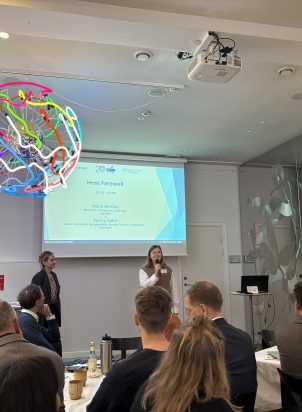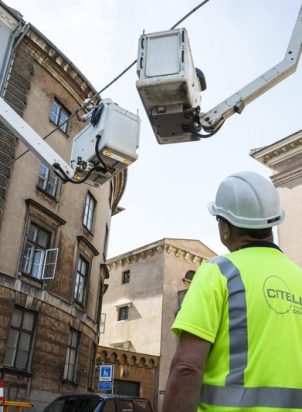In an increasingly digital world, the gap between those included in the transformation and those left behind becomes even more prominent. In the Nordic-Baltic Region, many civil society organisations are leading the charge to close this divide. Our new Storymap, Bytes and Rights covers the challenges and achievements in bringing digital inclusion to at-risk groups.
In recent years, civil society actors have received more responsibility for the work on digital inclusion – both from a political side and from increasing demands from their user groups. Despite this, we know little about what characterises their work, and what strategies and methods work well. We wanted to change this. Through desk research, a survey and interviews, we have mapped the support civil society actors offer socially at-risk groups across the Nordics and Baltics, as part of our research project Digital Inclusion in Action, in which we promote collaboration, dialogue, and knowledge sharing between practitioners and policymakers.
Key findings from Bytes and Rights
The research resulted in one of our most comprehensive Storymaps ever, where we give the word back to the civil society actors. “Bytes and Rights: Civil society’s role in digital inclusion” features insights from 17 NGOs and their approaches to include their target groups, such as older adults, people with disabilities, immigrants, socially vulnerable, rural communities, and youth. Our survey targeted 314 civil society actors across the Nordic and Baltic Region, and received 74 responses. 93% of them reported their target groups being at risk of exclusion, and 83% offered assistance to combat this. The civil society actors’ key approaches to aiding the target groups were:
- Skill development
- Strategic lobbying
- Monitoring digital inclusion/exclusion
- Technological development
- Creating awareness
- Providing access to hardware
- Monetary help
Despite their efforts, organisations face financial, societal, and political hurdles, putting spanners in the works:
Financial challenges: Insufficient funding, short-term planning, and limited personnel and time.
Societal challenges: Negative stereotypes (“it’s their own fault”), decreasing number of volunteers, and a lack of understanding of the groups’ complexity.
Political challenges: Prejudice against information about the groups, a lack of strategic focus, and insufficient prioritisation by policymakers.
In order to secure future support, civil society actors need more structured and frequent funding to meet increasing responsibilities, including administrative and overhead costs. The policy level also needs to recognise the complexity of the problem, groups, and solutions. To ensure that the support is effective, user involvement in designing solutions and policies from the start is key.
A comprehensive overview of civil society’s work
To mark the launch, a webinar featured representatives from four NGOs, each tackling digital exclusion in different regions and with various target groups. Senior researcher Sigrid Jessen presented the Storymap, providing a comprehensive overview of digital inclusion strategies across the Nordic-Baltic region. After desk research, interviews and survey analysis, Sigrid’s main take-away is this:
“Civil society actors gain increasing responsibilities, both from the bottom-up of user groups and from top-down policies that increasingly recognise their part of the solution in digital inclusion. However, this rising responsibility isn’t matched with adequate funding or support. That is the main key takeaway: if we want these actors to continue their successful efforts, we must provide them with the necessary resources and backing to sustain their work.”
Giving the word back to the actors
The launch webinar featured representatives from four organisations across the Nordic-Baltic Region working with various target groups using different methods. The first-hand accounts offered best practices and reflections on the future of integrating at-risk groups into the digital landscape.
Rósa María Hjörvar from the Icelandic Disability Alliance (ÖBÍ) highlighted how isolated communities face additional complexities in accessing digital tools, especially for sight-impaired individuals, as the accessible tools on the market do not assist in the Icelandic language, leaving them to develop their own solutions.
This do-it-yourself approach was shared with the next speaker, Mikael Carlsson Kerstell, of Swedish Byanätsforum, who shared their experience with community-driven broadband networks, stating, “If no one does it for us, we have to do it ourselves,” regarding the work of bringing digital infrastructure to rural communities.
Marika Sabroe, from the Danish National Association of Join in Places, reflected on how their digital initiatives help socially vulnerable individuals build a sense of community through digital activities. Marika shared learnings of how to replicate a physical experience in the digital world, to create the right premises.
Dovilė Dilienė, CEO of Lithuanian bit&Byte are also using the sense of community to strengthen their target group, youth: “We focus on creating continuous, inclusive environments so that all children, regardless of location or need, can see themselves as future tech creators.”
Nordregio’s research helps bridge the digital divide
The research project “Digital Inclusion in Action” continuously brings actors from across the Nordic and Baltic Region together to share learnings and network. With this webinar and publication, we underscore the importance of civil society in achieving digital inclusion. With continued support and collaboration between policymakers, civil society, and the private sector, the digital divide can be bridged, ensuring equal access for all across our regions.
Watch a recording of the webinar on the event page.





